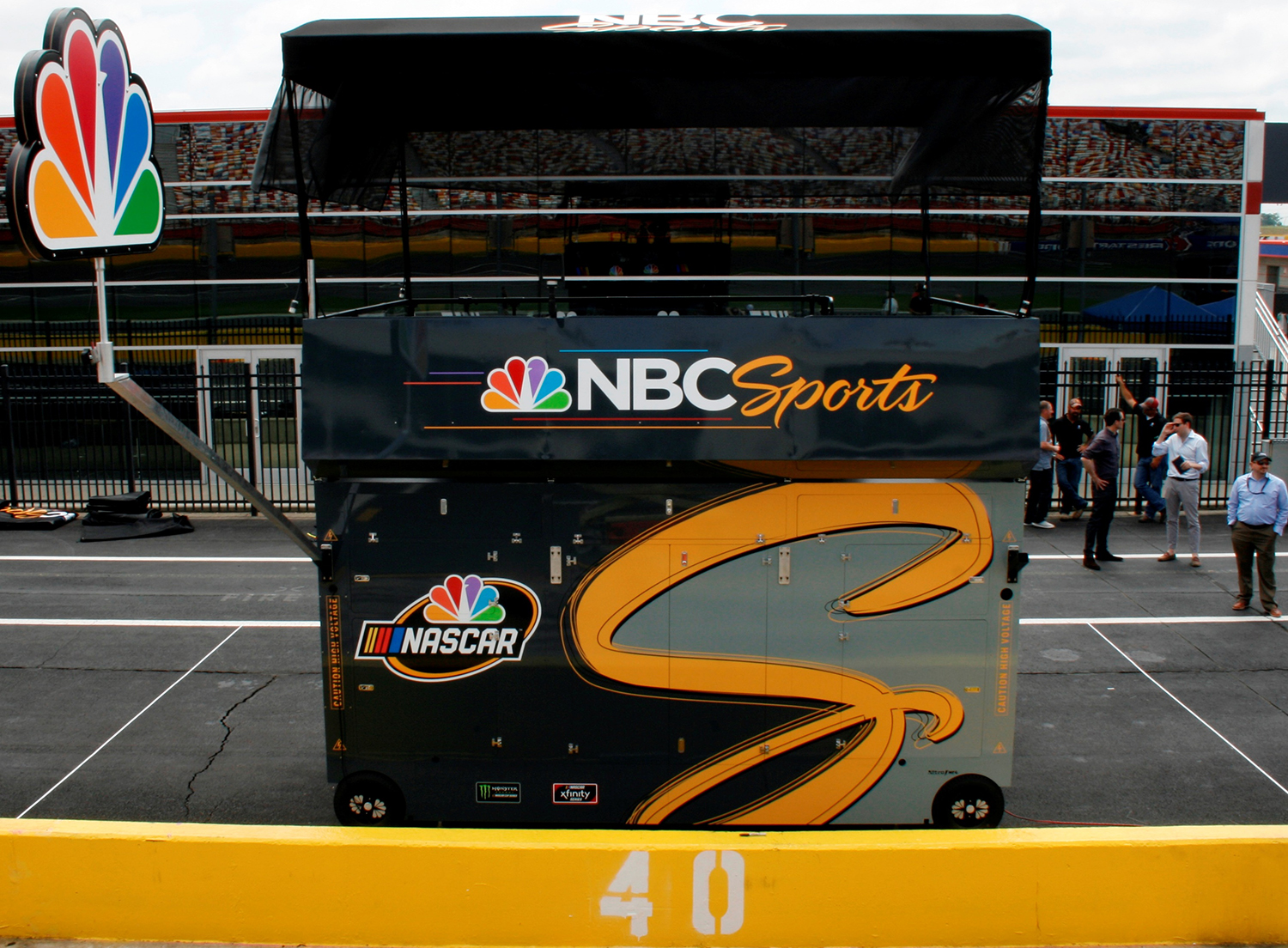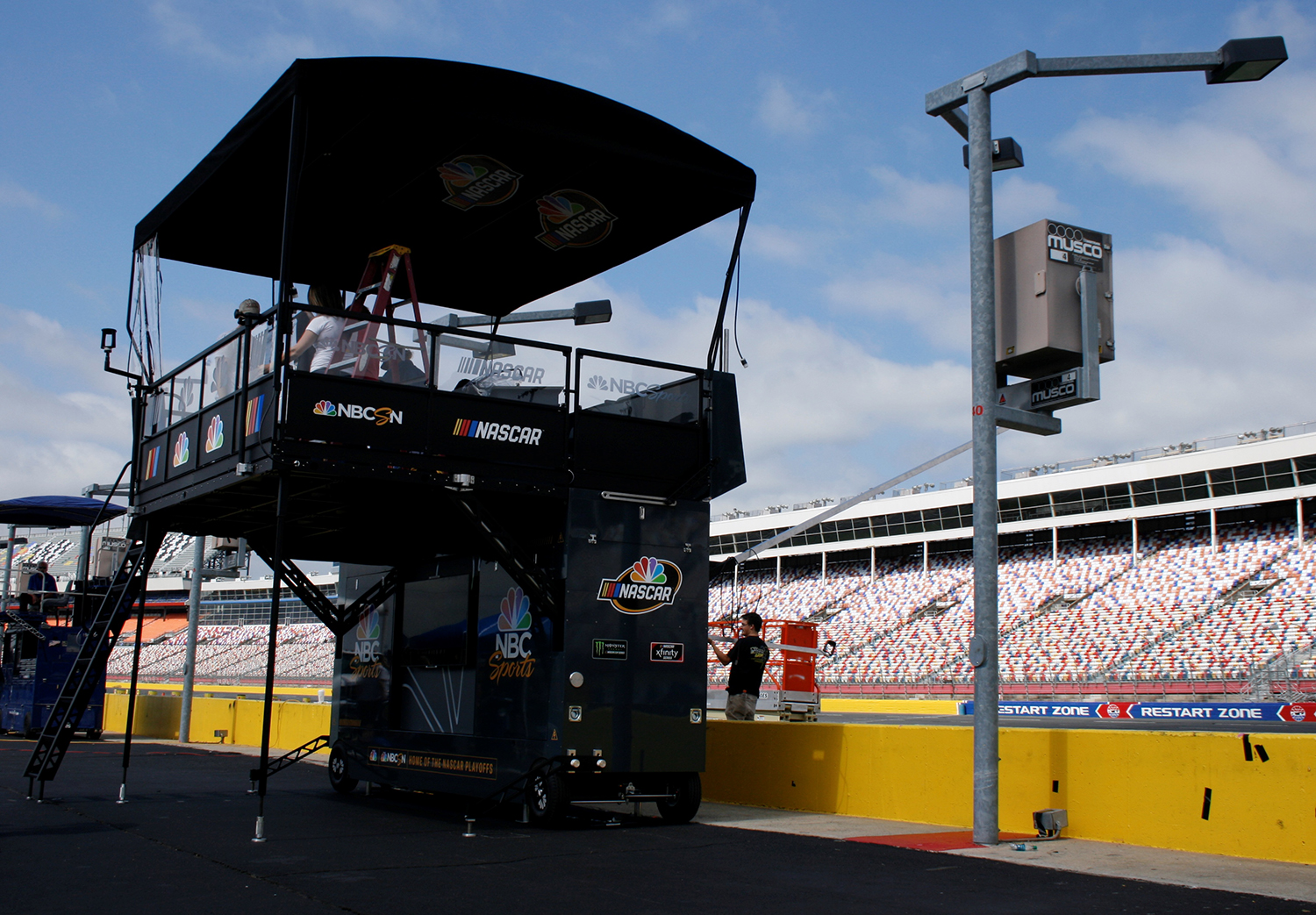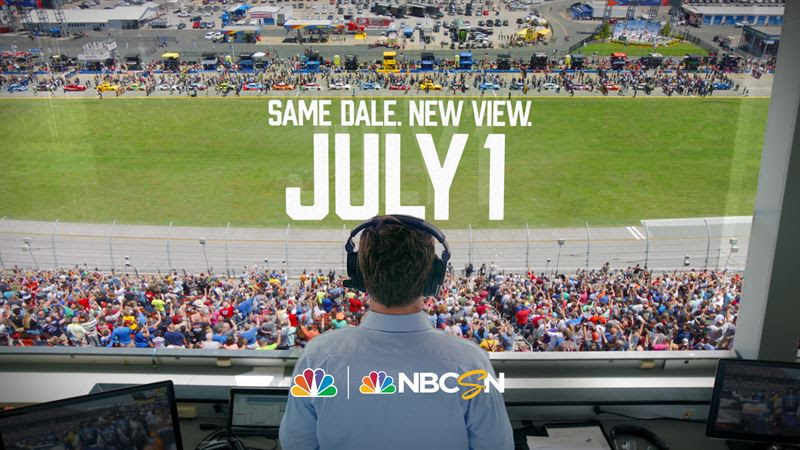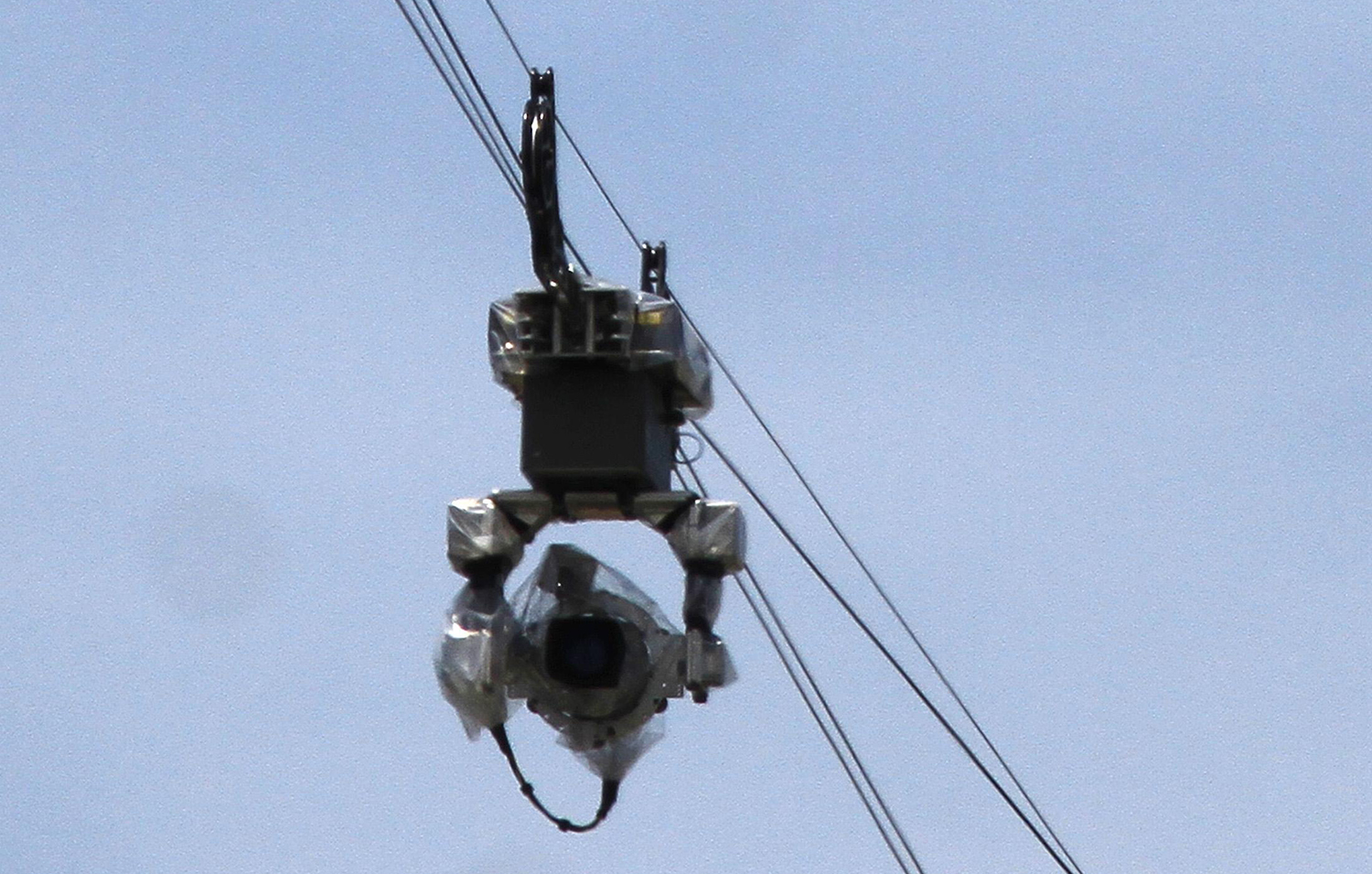NBC Sports Spreads Its Tech Feathers With New ‘Peacock Pit Box’ on NASCAR Coverage
The pre- and post-race set will provide viewers with inside access to pit road
Story Highlights
While the broadcast debut of Dale Earnhardt Jr. in the NASCAR on NBC booth is creating plenty of buzz around NBC’s first races of the season this weekend at Chicagoland Speedway, the uber-popular retired driver isn’t the only new addition to the network’s NASCAR coverage this year. Echoing its rink-side “Inside the Glass” position on NHL coverage, NBC will debut the Peacock Pit Box – a remote studio set built within a traditional pit box frame that will be located along pit road for pre- and post-race coverage at each speedway throughout the season.

NBC will debut the Peacock Pit Box – a remote studio set built within a traditional pit box located on pit road – for its NASCAR pre/post-game shows
“The Peacock Pit Box is going to put us in the middle of the action,” says NBC Sports Group Executive Producer Sam Flood. “We’ve had the big set down on the grid for the first three years of [our NASCAR rights] contract. We realized that sometimes the fans departed from that area as we got closer to race time and took away some of the sense of place. So the idea was to have a real sense of place throughout the day, starting with the pre-race show. And most importantly, it gives us a place inside that mayhem that is pit road, which has become one of the most exciting places at the racetrack each week.”
Inside the Peacock Pit Box: Two Levels With Plenty of Tech Firepower
The 14-ft.-long x 12.5 ft.-wide Peacock Pit Box (a normal-sized NASCAR pit box is 10×8 ft.) features two-levels and is located in a traditional pit box right along pit road. In addition to serving as the home to NASCAR on NBC’s pre-race coverage throughout the season, the structure also features an arsenal of robotic cameras that will aid in NBC’s coverage of pit road throughout each race.
“Sam [Flood] and Jeff [Behnke, VP, NASCAR production, NBC Sports Group] first had the vision and then there were a lot of great creative and technical people that helped to bring it to life,” says NBC Sports Technical Manager Eric Thomas. “They wanted to give our announcers a uniqe vantage point of the field of play – and that’s obviously pit lane. It’s like the 50-yard line in football or center ice in hockey. Our [announcers] will have an elevated position between all the teams right in the middle of the action, so they not only can see the racetrack but also see the competitors on either side of them.”
The NASCAR on NBC team worked with the NBC Sports Group design team in Stamford, CT, to design the Peacock Pit Box, while Nitro Manufacturing built the structure and Game Creek Video provided technical support and equipment.
The top level of the Peacock Pit Box will serve as the primary home from NBC Sports’ Monster Energy NASCAR Cup Series and Xfinity Series pre- and post-race coverage, with host Krista Voda and analysts Kyle Petty and Dale Jarrett occupying the desk. One handheld and three robotic cameras will be on hand for pre/post-race shows.

The 14-ft.-long x 12.5 ft.-wide Peacock Pit Box (a normal-sized NASCAR pit box is 10×8 ft.) features two-levels and is located in a traditional pit box right along pit road.
“It’s a nice dance floor that can support our announcers and various different configurations,” says Thomas. “We have to work within the space of the pit stall, which depends on the track. We have neighbors on either side of us, so we want to really be respectful of the teams and not interfere with them whatsoever. So we’re going to fit in our space very neatly and very cleanly without having an impact on the actual event. We wanted to make it as big as we could to make our announcers as comfortable as possible and also provide the technical equipment to produce a quality show.”
Meanwhile, the lower level of the Pit Box will provide additional broadcast positions with two wired cameras and an occasionally an RF camera and/or a small jib (depending on the size of pit box at each track). The space features interactive displays and a show-and-tell position for analysts like Daytona 500-winning crew chief Steve Letarte to deliver deeper analysis of the track action.
“The technology will be there for Steve to [provide deeper analysis], particularly in the Xfinity races, where he’s going to be hanging down on pit road in a pit box, restarting his old career of looking at the race when you only can see half the racetrack on pit road,” says Flood. “We think by [locating] Steve [there], it will give him more opportunity to focus that unique mind of his on what the heck all the other cars are doing on the track. So we see that as a huge advantage.”
The lower level also features a patio position where NBC will look to conduct interviews with drivers, pit crew chiefs, owners, and NASCAR officials throughout its race coverage.
All About Flexibility: Nine Robo Positions Give NBC Plenty of Options
Since NBC’s pre- and post-race setup will vary week-to-week depending on the track, Thomas and company were tasked with making the Peacock Pit Box as versatile as possible. With that in mind, the upper level features nine different robotic camera positions. Three robos can be deployed at a time and – thanks to the small, lightweight cameras and custom-developed camera mounts deployed on the Pit Box – the operations team can quickly swap camera positions at any time during NBC’s coverage.

Beloved NASCAR driver Dale Earnhardt Jr., who retired after last season makes his broadcast debut as NASCAR on NBC Analyst this weekend at Chicagoland.
“If our director wants to change the shot or we want to totally rotate 180 degrees, we can do that in about 10 minutes,” says Thomas. “If we want to do a show with the track in the background first and then, a few minutes later, we want to look toward the garage with a different set of announcers, we can move the cameras quickly and make that happen. So it’s very flexible.”
In addition to being used for pre- and post-race studio coverage, these robos will be utilized for coverage of the action on pit road throughout NASCAR on NBC telecasts.
“The cameras are going to pull double duty because, if something’s going on in pit lane, those cameras are still going to physically be there. So they are going to give us some different angles that we haven’t seen very much of in the past,” says Thomas. “We’ve tried to create as much flexibility as possible so when Sam and Jeff ask, ‘can we do this?’, then we can say, ‘of course you can.’”
BatCam Returns: Aerial System Headlines NBC’s Army of Cameras
NBC Sports will deploy an average of 55 cameras – including the return of the BatCam point-to-point aerial system to cover the backstretch – on big races at Daytona, Indianapolis, and Homestead-Miami this season. Thomas also expects to use BatCam, which debuted last year and can hit speeds of over 100+ mph, at the Watkins Glen road course this year. The BatCam also drew rave reviews throughout NBC’s Triple Crown coverage this past spring.

NBCS Sports is bringing back the BatCam point-to-point aerial system will to cover the backstretch at NASCAR races
The bulk of NBC’s camera complement for NASCAR is made up of Sony HDC-4300’s along with a mix of robos (provided by Robovision) and roving RF cameras. BSI will once again be providing eight RF in-car-camera dual-path systems, which allow two angles to be transmitted from each car at any given moment. Thomas also says his NASCAR on NBC team is currently experimenting with several new camera positions, which he expects to roll out throughout the season.
Going Inside the Action With New Graphics, Analysis Tools
NBC is utilizing SMT’s tools for the fourth straight NASCAR season. This year, the SMT race crawl has been updated to show the live running order and driver statistics at the traditional position on top of the screen and in a new vertical pylon display on the left side. The multiple options provide production with a variety of ways to allow fans to track each driver.
Also new this year is the SMT GOTO interactive touchscreen display, which provides several tools NBC can use throughout each race weekend, giving on-air analysts the ability to telestrate highlights, compare drivers and statistics, and interact with fans on social media.
SMT’s new Broadcast Analytics system has also been added to help enhance the coverage. The system live tracks all the cars during each session and allows production to show a virtual replay of any lap run during practice, qualifying and the race. The system allows production to visualize any lap run by any driver. It can provide a combined display of how a single driver ran on different laps, showing changes they’ve made during the session. The system can also show how different drivers ran the same lap. All of these options will allow fans to see the key moments during each session and better understand how that impacted where each driver finished.
In the Compound and Back Home in Stamford
Game Creek Video’s PeacockOne (A and B units) will once again serve as the home to the NASCAR on NBC production team on-site, while an additional pair of Game Creek trucks will house mix effects and editing, as well as robo operations and tape release. In all, NASCAR truck compounds will be stocked with an average of 19 trailers (including BSI, Sportvision, NASCAR operations, and more).
“NASCAR does a great job setting up the compounds for us and providing a beautiful sandbox for us to play in,” says Thomas.
In addition, the NBC production team continues to increase rely more and more on file-sharing with the NBC Broadcast Center in Stamford, CT. AT&T and PSSI have partnered established fiber connectivity at the majority of the NASCAR tracks and will provide NBC with a circuit back to Stamford for file-transfer, as well as home-running individual cameras for at-home productions. Pre- and post-race shows from the Peacock Pit Box will regularly send back cameras to a control room in Stamford, where the show will be produced.
“We started [producing shows out of Stamford] last year and we will expand it more this year,” says Thomas. “It worked well last year and we’re making some improvements this year to make it even more seamless. With the increased support from AT&T and PSSI for network connectivity, I think it’s going to be even better this year. Obviously there are big cost savings on travel [as a result], but the product is of the same quality – so it’s really a win-win.”
